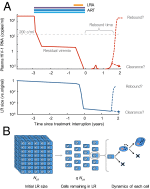Predicting the outcomes of treatment to eradicate the latent reservoir for HIV-1
- PMID: 25097264
- PMCID: PMC4169952
- DOI: 10.1073/pnas.1406663111
Predicting the outcomes of treatment to eradicate the latent reservoir for HIV-1
Erratum in
- Proc Natl Acad Sci U S A. 2014 Oct 28;111(43):15598
Abstract
Massive research efforts are now underway to develop a cure for HIV infection, allowing patients to discontinue lifelong combination antiretroviral therapy (ART). New latency-reversing agents (LRAs) may be able to purge the persistent reservoir of latent virus in resting memory CD4(+) T cells, but the degree of reservoir reduction needed for cure remains unknown. Here we use a stochastic model of infection dynamics to estimate the efficacy of LRA needed to prevent viral rebound after ART interruption. We incorporate clinical data to estimate population-level parameter distributions and outcomes. Our findings suggest that ∼2,000-fold reductions are required to permit a majority of patients to interrupt ART for 1 y without rebound and that rebound may occur suddenly after multiple years. Greater than 10,000-fold reductions may be required to prevent rebound altogether. Our results predict large variation in rebound times following LRA therapy, which will complicate clinical management. This model provides benchmarks for moving LRAs from the laboratory to the clinic and can aid in the design and interpretation of clinical trials. These results also apply to other interventions to reduce the latent reservoir and can explain the observed return of viremia after months of apparent cure in recent bone marrow transplant recipients and an immediately-treated neonate.
Keywords: HIV cure; HIV latent reservoir; viral dynamics.
Conflict of interest statement
The authors declare no conflict of interest.
Figures




Comment in
-
Stochastic variability in HIV affects viral eradication.Proc Natl Acad Sci U S A. 2014 Sep 16;111(37):13251-2. doi: 10.1073/pnas.1413362111. Epub 2014 Sep 8. Proc Natl Acad Sci U S A. 2014. PMID: 25201951 Free PMC article. No abstract available.
References
-
- Chun TW, et al. Quantification of latent tissue reservoirs and total body viral load in HIV-1 infection. Nature. 1997;387(6629):183–188. - PubMed
-
- Siliciano JD, et al. Long-term follow-up studies confirm the stability of the latent reservoir for HIV-1 in resting CD4+ T cells. Nat Med. 2003;9(6):727–728. - PubMed
-
- Archin NM, et al. 2014. Measuring HIV latency over time: Reservoir stability and assessing interventions. 21st Conference on Retroviruses and Opportunistic Infections (Boston), Abstract 406.
-
- Ruiz L, et al. Structured treatment interruption in chronically HIV-1 infected patients after long-term viral suppression. AIDS. 2000;14(4):397–403. - PubMed
Publication types
MeSH terms
Grants and funding
LinkOut - more resources
Full Text Sources
Other Literature Sources
Medical
Research Materials

